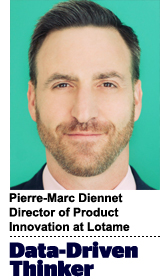
“Data-Driven Thinking” is written by members of the media community and contains fresh ideas on the digital revolution in media.
Today’s column is written by Pierre-Marc Diennet, director of product innovation at Lotame.
The current value of agency holding companies is their buying power. They achieve volume pricing by buying huge swaths of inventory in advance and dividing it up among their clients. When the effectiveness of any one piece of inventory is difficult or impossible to measure, buying a lot of inventory at a reduced price is a great way to mitigate losses when some is bad or useless.
However, when marketers can measure the effectiveness of an individual inventory source, placement or creative, the value of this volume strategy nosedives. If a brand knows exactly what and how much it wants to buy, it will simply make that purchase; and while it may pay more for that particular media, it will be confident of its value.
Another threat to the holding groups’ value proposition is the overmentioned walled gardens, which provide much of the same full service to brands as holding group agencies. They offer research, media buying, measurement and (to a growing degree) even top-notch creative services. Facebook Creative Shop is winning many accounts, and Spotify’s in-house agency was just named in-house agency of the year.
So, what can the holding groups do to maintain their value to their brand clients? How can they leverage their scale and survive in a more measurable environment?
The answer might not be that complicated and require changing very little of their current proposition. It may be as simple as doing everything they already do very well, such as providing top-tier creative, a volume pricing advantage and negotiation strength for brands, but also investing in two key areas.
POV
As a global organization, the holding groups have a unique point of view: They sit on top of all the ad platforms.
This allows them to track price and effectiveness across all of them. Holding companies can see how well Facebook campaigns perform compared to YouTube campaigns and Amazon campaigns. They can see the “spend vs. outcomes” data across platforms, channels and brands. This is something that no other entity in the world can do, and it can be very powerful. Essentially, the holding groups can see over the walls and into the gardens.
To take advantage of their unique point of view, data science and data architecture investments will help them build a powerful analysis engine that can churn out media plans, creative recommendations and effectiveness studies. A small investment here can go a long way.
One might need to build the cross-platform analysis once or twice a year and use it in every pitch or planning session with every client for that season. If that one report adds even a small amount of efficiency – something in the range of 1-3% for each of the holding group’s brands – that’s a big win.
Tech expertise
It has been my experience that there is very little technical expertise sitting outside of the big tech platforms. Since technical prowess is still relatively rare at the senior level, tech companies spend many cycles trying to educate their customers about how to actually use their technology. By virtue of having so many brand clients, the holding groups have had to educate themselves about the capabilities of technology, and this is a very important strength. They have the opportunity to add an educational efficiency to the industry, to act as a point of expertise and to be a valuable link between brands and big technology stacks.
An investment should be made in technical expertise teams who can run all things for brands. With this strategy, there would be less building of new technology and more vetting, combining, and maximizing existing technology on behalf of brands. For each brand, there might be one senior technology lead and a team of savvy and fast operational folks to execute on their behalf.
Tech is not easy – mistakes get made – but the less time there is to spend learning a new technology and the more time that can be spent digging into an existing one, the better. Technical expertise can be swiftly spread across the holding group and leveraged to advise and execute for customers at scale. Many think Google tech support is horrible, which is a great thing for holding groups. This is where they can add true value: as tech consigliere to the major brand bosses.
Inevitably, there is going to be more contraction in the advertising space as industries get disrupted and platforms are consolidated, but we can all be confident that things will get more technical, not less.
We can also be confident that the amount of data available to analyze is going to increase and not decrease. The holding groups needn’t feel an existential threat from this. They can preserve their position and maintain their role of brand consigliere.
Follow Lotame (@Lotame) and AdExchanger (@adexchanger) on Twitter.
This post was syndicated from Ad Exchanger.


More Stories
GSTV Wants To Turn Gas Stations Into A Video Ad Marketplace
Chicken cake marks ten years for Bostock Brothers
Adam Scott Adds ‘Facial Hair Enthusiast’ to His CV in Philips Norelco Campaign